Steve s
Harmless

Posts: 46
Registered: 20-2-2019
Member Is Offline
|
|
HHO welder for glasswork
Hi All
I'm looking to purchase a HHO acrylic finisher/welder, partly (mostly) as they sound pretty cool but also in the hope that i might be able to use it
for doing a bit of glass work. I'd like to have a go at putting some of the elements in my collection in nice bespoke ampoules some under argon some
in vacuum.
I'm guessing this has been tried before although despite a Google search and a search through a few of the threads on here i've not found much info on
it.
I am aware that there are various tried and tested cylindered gas and high current electric methods for doing this but i would like to know if the HHO
method would work.
Also any tips re the actual set up and use of the HHO generator would be much appreciated.
This is the machine i'm looking to purchase:
https://www.ebay.co.uk/itm/Oxygen-Hydrogen-Welder-Flame-Poli...
[Edited on 15-4-2020 by Steve s]
|
|
|
earpain
Hazard to Others
  
Posts: 102
Registered: 11-9-2019
Member Is Offline
|
|
Hi. Though I do not have an answer for any of your questions, I'm delighted to say that I am pursuing a very similar project, and maybe some of my
research and experience so far would of help:
Project: Build an H2 generating tank with a welding torch tip. And use this specifically for scientific glass lampworking.
In my case I plan to generate the H2 via KOH + Al(metal) inside of a fire extinguisher. Based on some (bold) DIY welding and metalworking youtube
gurus experiments, I know that such a device can be made safely. I would use a water bubbler as a flash-back arrestor.
This would make a small syringe sized torch tip, with H2 burning with ambient O2 at the hottest temperature of any welding torch possible.
I do glass work but don't like to purchase O2. This of course limits my ability to get any thick glass hot enough to be workable. Also I can't
adjust for a more O2 rich mixture, to create a sharper, smaller, hotter, blue flame.
Anyone reading this is likely well aware that a super hot, but very small torch flame tip would be more or less useless for glass work, since glass
must be annealed , before and after the actual process, and any aperatus, or especially joining of tubings , would need to have unlocalized heat in
every way feasible.
So I would have an air carbureted propane torch, on while my H2 torch is by my side. Thus far, I'm not aware of anyone, even on youtube or anywhere,
using H2 + O2 flame for working glass. It might just not work at all. But I will post about it regardless.
|
|
|
Chemetix
Hazard to Others
  
Posts: 375
Registered: 23-9-2016
Location: Oztrayleeyah
Member Is Offline
Mood: Wavering between lucidity and madness
|
|
A small torch for welding work could be feasible, like a Harris contractors handtorch, with a Harris # 8 tip for example. For ampoule and small work
this could be done. But it gets hard when need something larger. It's an energy problem. How many amps can you get out of a wall socket? Say 10 amps
at 240V gives you 2400 Watts. Assume you get half that in electrolysis products and so you get enough gas to give you back the full amount of energy
back as heat when you recombine them, so you have 1200W of heating.
As a glass blower I've done some crude calculations based on flow of propane and oxygen to the torch at a setting I commonly work with and it's around
the 5 to 8 kW range coming from the heat of combustion. This makes the amount of amps coming from a domestic electricity supply not just unfeasible
but expensive.
You would need a series of traps before the delivery line to stop flash back, since you have a stoichiometric mixture running it would easily
propagate a detonation down the hand torch and into the line.
|
|
|
earpain
Hazard to Others
  
Posts: 102
Registered: 11-9-2019
Member Is Offline
|
|
Quote: Originally posted by Chemetix  | A small torch for welding work could be feasible, like a Harris contractors handtorch, with a Harris # 8 tip for example. For ampoule and small work
this could be done. But it gets hard when need something larger. It's an energy problem. How many amps can you get out of a wall socket? Say 10 amps
at 240V gives you 2400 Watts. Assume you get half that in electrolysis products and so you get enough gas to give you back the full amount of energy
back as heat when you recombine them, so you have 1200W of heating.
As a glass blower I've done some crude calculations based on flow of propane and oxygen to the torch at a setting I commonly work with and it's around
the 5 to 8 kW range coming from the heat of combustion. This makes the amount of amps coming from a domestic electricity supply not just unfeasible
but expensive.
You would need a series of traps before the delivery line to stop flash back, since you have a stoichiometric mixture running it would easily
propagate a detonation down the hand torch and into the line. |
I absolutely agree that the electrolytic simulteanous generation of H2 and O2 is a. would never be worth the cost in electricity and b. the two
ingredients are being generated together, that's super dangerous.
With the Al + hydroxide method, my 1L pressure vessel would have about 30 L of H2 gas if I recall correctly? It has a pressure gauge on it. I think
the only chance of flash back ignition would be once the H2 is almost gone, though by then the torch would be burning out anyway.
edit: My apologies I should credit my source: https://www.youtube.com/watch?v=cAZJN3sZEc0
Unfortunately it is not translated and although he demonstrated first via equations, and then via demonstration that there was no real danger, he
ended up taking the video down, and replaced it with an electrolytic H2 one
[Edited on 15-4-2020 by earpain]
|
|
|
Steve s
Harmless

Posts: 46
Registered: 20-2-2019
Member Is Offline
|
|
Thanks for the replies
Certainly a fair bit to think about, especially the annealing part never knew about this so will have to look into it future but to clarify, is it
just the part that has been heated/worked on that needs to be annealed or the whole piece ? Heating an ampoule (sealed test tube) with a volatile
sample in it to 400oC seems very risky 
In all probability it will be small work that i'll be doing but small is a relative term, i'm most likely going to be using test tubes 10mm/16mm and
possibly some thin wall 'boiling tubes' as apposed to actual ampoules. Do you think the 95l per hour machine i'm looking at would be ok for this ?
Re power, i could feasibly install a 16 or even 32 amp socket which would give me a fair bit more available input but then i'd have to be going down
the DIY HHO generator which although i'm not against the idea (fair bit of time on my hands ATM) it would involve a lot of acquiring bits and pieces
which would take time so if i can buy a plug and play version that will do the job i would rather do just that.
[Edited on 16-4-2020 by Steve s]
|
|
|
earpain
Hazard to Others
  
Posts: 102
Registered: 11-9-2019
Member Is Offline
|
|
I think others here would be better suited to address the electrolysis efficiency matters.
As for the glass work:
Well if I had a 10mm tube, proper borosilicate, that was thin - medium walled, I could 'close off' one end with a $10 plumber's propane torch.
And the pre-annealing in that case would be mean just twirl the end over a lower flame for maybe 30 seconds just to be safe, and since the goal would
be to have it closed off with uniform consistency , meaing wall thickness, which would mean maybe 2 - 3 rounds of flame twirl -> gently blow
->flame twirl(gather ->gently blow.
That I would just set aside to cool down naturally on a piece of ceramic tile or just a plate.
Actually I'm not sure how sealing off off an ampoule is done , esp. with substances inside. I'm actually going to look it up.
Now this same process when scaled to say, 20mm heavy wall tubing, which would be used to make things like most condensors or 50mm - 500mm RBF's etc.
then a lot more goes into consideration of final consistency ESPECIALLY at the joining sites(making a liebig condenser even is quite an interesting
process). That involves a lot of prep work on the joining sites just to achieve a solid final structure, that also is uniform. In this case a kiln
is recommended to slowly cool down or at least a bucket of vermiculite.
You may still need to approach your problem this way if your ampoules are being made from 16mm heavy wall tubing, but if you're just trying to close
off the tube smoothly, you can just apply the approach i described for 10mm tubing, BUT a plumber's torch would not suffice. Even if I was able to
close it off with a plumber's torch, i wouldn't have the heat capacity to EVENLY heat up the whole area around and including the seal without
oxy/propane, to then be able to set it down without it cracking. Or otherwise cracking at some point in the future.
[Edited on 16-4-2020 by earpain]
[Edited on 16-4-2020 by earpain]
|
|
|
draculic acid69
International Hazard
    
Posts: 1371
Registered: 2-8-2018
Member Is Offline
|
|
I doubt that a homemade hho torch flame is big enough to do glassware.i think it's hot enough but not big enough.i reckon the size of the flame is
very important for glass and a homemade one ain't gunna cut it.also u know the electrolysis cell attached to your pool filter would be a good thing to
consider using as it's meant to handle electricity and water whereas a homemade one using aluminium or ss will fail quicker and not be as
efficient.just a thought.
|
|
|
earpain
Hazard to Others
  
Posts: 102
Registered: 11-9-2019
Member Is Offline
|
|
Quote: Originally posted by draculic acid69  | | I doubt that a homemade hho torch flame is big enough to do glassware.i think it's hot enough but not big enough.i reckon the size of the flame is
very important for glass and a homemade one ain't gunna cut it.also u know the electrolysis cell attached to your pool filter would be a good thing to
consider using as it's meant to handle electricity and water whereas a homemade one using aluminium or ss will fail quicker and not be as
efficient.just a thought. |
Agreed. In the video the flame was very thin, maybe the size of half a pencil. He showed how it would immediately melt any metal into a puddle.
This would be like a cutting flame, setting the oxygen as high, and propane/acetylene as low as you can without the flame going out.
In lampworking glass this type of flame is crucial, but without its counterpart red, wide heat, it would be impossible to work glass.
But some things I think the H2 flame would make possible:
After diamond polishng a broken flask neck, along with a recycled or new ground glass connector, heating the two and making a weld. It would still
be a challenge as it would be regardless of the flame, but with simple propane or mapp gas, it's not even possible.
Easily work tiny quartz tubing. Quartz can better handle the thermal shock of being exposed to an H2 flame, and finally, the flame would actually be
hot enough to close off tubing, blow out tubing a bit probably, make 3 way joints. Possibly fill quartz with an inert gas, or vacuum and seal it off.
Sounds like a fun time to me.
In the video he uses a high quality fire extinguisher, and thin PVC or similar 'rubber' line, and metal syringe tips, but eventually I think just a
thin copper tube as the torch tip.
He regulates the flow by drilling a hole in the handle of the fire extinguisher, and inserting a long threaded lug. It very impressively creates a
gradient to the on/off valve normally spring loaded.
Also, he demonstrates via the gauge on the fire extinguisher, that after filling it p to 100 PSI with H2 , and leaving it at his shop on a thursday
night, the following Monday the pressure gauge had barely moved. So H2 is a small molecule, but it can be contained.
|
|
|
draculic acid69
International Hazard
    
Posts: 1371
Registered: 2-8-2018
Member Is Offline
|
|
A weldable fire extinguisher would be ordinary steel then wouldn't it?
Will hydrogen embrittlment not cause an issue
|
|
|
earpain
Hazard to Others
  
Posts: 102
Registered: 11-9-2019
Member Is Offline
|
|
Well thank you, my confidence in the safety of this project is temporarily on pause.
You know a scimad challenge has occured when the second sentence you read about something new is:
"Hydrogen embrittlement also known as hydrogen assisted cracking and hydrogen-induced cracking, describes the embrittling of metal after being exposed
to hydrogen. It is a complex process that is not completely understood because of the variety and complexity of mechanisms that can lead to
embrittlement. "
Well it appears there is a way to test for it.
Fire extinguishers tend to be held to above average scrutiny as pressure vessels because of those handful of times that someone tried to put out a
famous fire, but the fire extinguisher within reach had lost its pressure long before.
But honestly I don't know much more than that about the specifics of the metal that would be used.
I highly doubt plain steal or plain anything, that could corrode , would be used.
Just like it wouldn't be for any gas cylinder.
I'll do some reading. Cheers!
|
|
|
Steve s
Harmless

Posts: 46
Registered: 20-2-2019
Member Is Offline
|
|
Earpain. So in short the HHO approach is unlikely to work on anything as far as ampoule making/sealing is concerned but i think i get where you're
going with the very fine repairs and hole blowing. However that is all way out of my league at this time. I spent a couple of hours earlier today
trying the various gas heating implement i have, pen micro soldering torch through to mapp gas plumbers torch on various types and sizes of test tubes
with varying degrees of success. I didn't bother with slow cool annealing of anything as i'm still just trying to get my technique right but i have
taken your advice about it on board and i give it a go once i'm confident i can consistently produce decent neat seals. I do however have another
question Re annealing; How do i test a finished piece (ampoule) for structural integrity without breaking it or if testing 'test pieces' to
destruction what would the usual parameters re pressure, physical and/or temperature shock. I know this is a bit of 'how longs a piece of string'
question but if you have a basic method i'd be interested to hear about it.
Draculic acid69. Firstly rather amused that you think i'd have a pool, i'm in the UK, no point  Yes i suspect you are right about the flame being to small certainly for the purpose i had in mind. With regards to
DIY HHO generators some are pretty impressive flow, pressure and flame size. I see a youtube video (can't find it ATM) when i was researching flash
back DIY arrestors/bubblers and came across one where some chap was experimenting with using some sort of organic solvent (DCM i think) in his bubbler
which actually prevented flashbacks from happening in the first place. Anyway he managed to get a pretty decent flame from his homemade set up
(apparently running of standard mains socket) so guess it can be done but it does look like a lot of work. Yes i suspect you are right about the flame being to small certainly for the purpose i had in mind. With regards to
DIY HHO generators some are pretty impressive flow, pressure and flame size. I see a youtube video (can't find it ATM) when i was researching flash
back DIY arrestors/bubblers and came across one where some chap was experimenting with using some sort of organic solvent (DCM i think) in his bubbler
which actually prevented flashbacks from happening in the first place. Anyway he managed to get a pretty decent flame from his homemade set up
(apparently running of standard mains socket) so guess it can be done but it does look like a lot of work.
Now i just need to think of some other reason to justify the acquisition of a HHO generator, cause i still kinda want one 
|
|
|
earpain
Hazard to Others
  
Posts: 102
Registered: 11-9-2019
Member Is Offline
|
|
Quote: Originally posted by Steve s  | | Earpain. So in short the HHO approach is unlikely to work on anything as far as ampoule making/sealing is concerned but i think i get where you're
going with the very fine repairs and hole blowing. However that is all way out of my league at this time. I spent a couple of hours earlier today
trying the various gas heating implement i have, pen micro soldering torch through to mapp gas plumbers torch on various types and sizes of test tubes
with varying degrees of success. |
Steve S:
I think some pictures will inspire 1000 thoughts. I highly recommend most chemists to never ever bother with this sort of lunacy. As soon as I
purchased the real version of these devices, I never bothered again.
But...making them myself first, really added to my understanding, appreciation, and overall intimacy(ha) with glassware, and heat, and well all that
stuff we do.
All of these are examples of my glass blowing being used for chemistry(specifically flame working, the cold working comes in handy twice as often)
The last pictures shows what turned out to be a successful molecular distillation(via fridge pump vacuum of course) of delta-9-THC and other heavy
oils of similar nature(approaching 200C at .01 torr absolute).
The heating vessel was a $3 USD 'decorative test tube' I bought at an art supply store that had warning labels on it such as : "Do not heat.
Decoration only".
I blew out the flask from the test tube. I casted the silicone molds. I finally got the distillate when I ran hot water through the condenser, made
from boro glass from a broken lab item.
One tip: Make sure when using propane or Mapp gas, that you don't have the type of torch known as a "pencil tip". Those are good for getting stuck
bolts loose from metal, never glass.
I usually initially attempt boiling water in something before doing anything more interesting , but sometimes I just skip straight to whatever I
needed the device for. If it survives melting, blowing, and changing shape, it will likely survive a sand bath or hot plate.
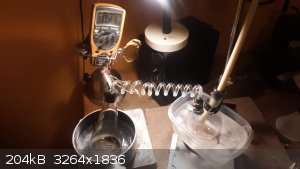 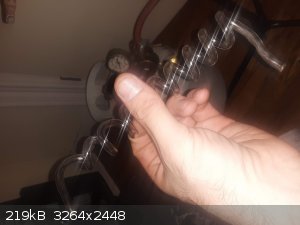 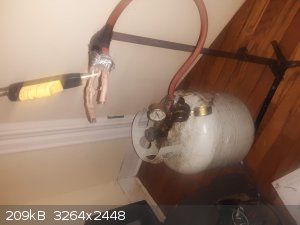 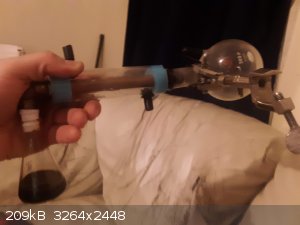 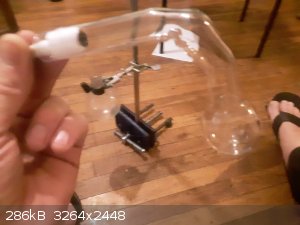
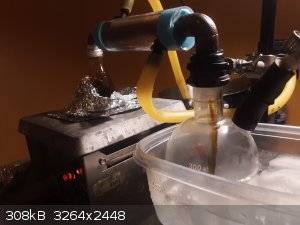
|
|
|
Steve s
Harmless

Posts: 46
Registered: 20-2-2019
Member Is Offline
|
|
Wow that is some pretty impressive work, necessity really is the mother of invention 
I take it the hot water through the condenser was to get the distillate to flow after it condensed into a syrup ?
Glad you mentioned 'the torch tip' i'm actually planning on ordering an oxy/fuel set tomoz. The one i have in mind is for lead work/plumbing (and
heating rusted bolts  ) This one to be precise: ) This one to be precise:
https://www.ebay.co.uk/itm/CASTOLIN-PORTABLE-GAS-LEAD-WELDIN...
I'm guessing these are the pencil tip nozzles you speak of ??
Annoyingly i have an actual oxy/fuel glass work torch (that i rescued before it was binned) in my desk at work unfortunately i don't think i'm going
to be able to go get it any time soon 
|
|
|
wg48temp9
National Hazard
   
Posts: 761
Registered: 30-12-2018
Location: not so United Kingdom
Member Is Offline
|
|
The HHO welder in the first post had a nominal input power of 330W so with an efficency of 50% that's a torch flame of only 165W assuming the boost
(HHO storage) is not used.
Steve The small oxy/fuel units are nice I had one once but the bottles do not last very long and they are expensive to buy at about £30 each.
I am wg48 but not on my usual pc hence the temp handle.
Thank goodness for Fleming and the fungi.
Old codger' lives matters, wear a mask and help save them.
Be aware of demagoguery, keep your frontal lobes fully engaged.
I don't know who invented mRNA vaccines but they should get a fancy medal and I hope they made a shed load of money from it.
|
|
|
earpain
Hazard to Others
  
Posts: 102
Registered: 11-9-2019
Member Is Offline
|
|
Quote: Originally posted by Steve s  | Wow that is some pretty impressive work, necessity really is the mother of invention 
I take it the hot water through the condenser was to get the distillate to flow after it condensed into a syrup ?
|
Thanks kindly. Yes this is something I have only ever encountered in the odd and unique context of Short Path aka Molecular distillation of a heavy
oil.
Since 'boiling' ceases to exist as a process at that vacuum, I rely on a stir bar, and brute angry heat to escort the distillate across. There is
only one stage there, the yellow syrup was the purified product.
Quote: Originally posted by Steve s  |
Glad you mentioned 'the torch tip' i'm actually planning on ordering an oxy/fuel set tomoz. The one i have in mind is for lead work/plumbing (and
heating rusted bolts  ) This one to be precise: ) This one to be precise:
https://www.ebay.co.uk/itm/CASTOLIN-PORTABLE-GAS-LEAD-WELDIN...
I'm guessing these are the pencil tip nozzles you speak of ??
Annoyingly i have an actual oxy/fuel glass work torch (that i rescued before it was binned) in my desk at work unfortunately i don't think i'm going
to be able to go get it any time soon 
|
My statement about the torch tip only applies to ambient oxygen mix. I used one of the most popular torches for metal in the US, "Victer", with
Oxy/Propane, long ago, this was enough to handle any glasswork on borosilicate needed. The tip is super skinny. Doesn't matter at all when you
(hopefully) have gas knob valves right within reach on the torch as you're working.
Interesting 'fuel' that product references. I saw a number on the tank in the picture. With compressed oxygen, and just about any fuel, you
should be able to do much more than what's listed there, with metal that is.
Rusty bolts: The worst of them, I would heat whatever the bolt was stuck inside of with atmospheric mapp gas, then take a step back, and quench with
penetrating catalyst, followed by a bang with a hammer.
Yes here they sell these red oxygen tanks meant for a two tiny tank torch, I think that would supply 20 min or so of useful sized flame.
If I couldn't drill into the bolt that is.
Anyway, the pictures seem to suggest valves at the torch, though this is not listed as a feature. You really should not be using the regulators to
shift between flame types, but the needle valves are a pretty standard part for metalworking setups as well, so it'll will likely have them.
Anybody ever try using forced air? I built one via propane and a computer fan. That was the biggest and hottest flame I've ever made, but that
device needs some detailing before I try to use it again.
|
|
|
Steve s
Harmless

Posts: 46
Registered: 20-2-2019
Member Is Offline
|
|
So the kit in the link will be ok for my purpose (making ampoules)? I tried sealing a pyrex boiling tube with my mapp gas torch (ambient oxygen) and
although after a minute or so it did get hot enough to distort/bend slightly i could not pull and seal it, hence the oxy/fuel kit.
|
|
|